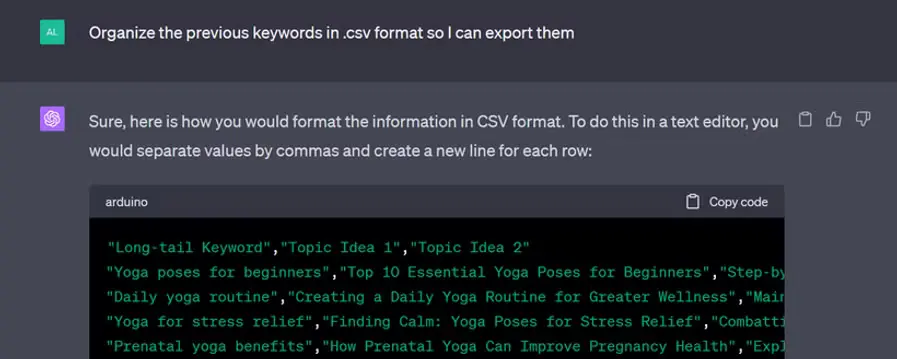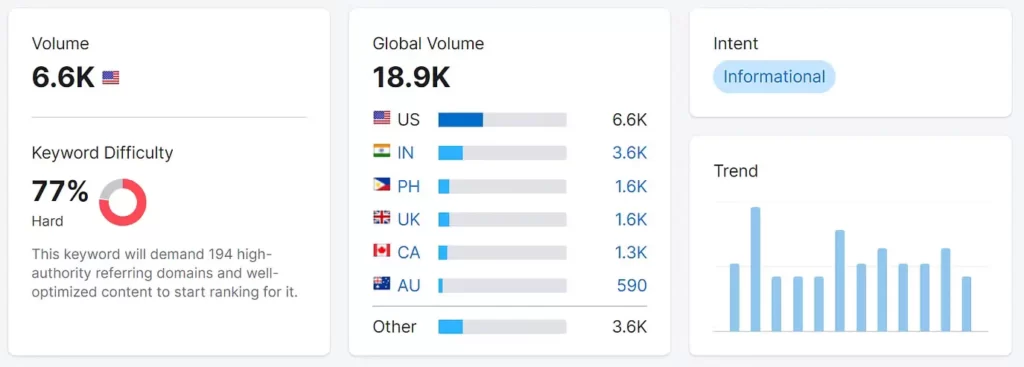Learning how to do keyword research with ChatGPT is easier than you might think. Even though the AI tool wasn’t designed with Search Engine Optimization (SEO) in mind, it can be incredibly helpful in coming up with keyword and content ideas (and even business names).
Understanding what ChatGPT can do and what its limitations are will enable you to leverage it as an SEO tool. It’s not going to beat dedicated keyword research tools due to the way it works, but what it can do is help you come up with massive numbers of ideas quickly.
In this article, we’ll show you how to do keyword research with ChatGPT including real examples. Let’s get to work!

Step 1: Start with seed keywords 
“Seed” keywords are the fundamental terms or phrases that you can use to define your niche, and they’re the first step in learning how to do keyword research with ChatGPT. These are typically not the keywords that you’ll focus content around, as they tend to be too broad and generic. To give an example, here’s a list of potential seed keywords for the fitness niche:
- Exercise
- Workout
- Gym
- Health
- Nutrition
If you focus on those types of keywords when creating content, it’ll be nearly impossible to rank for them. Not only are the terms too broad, but they’re also incredibly competitive.
The goal of determining seed keywords is to help you come up with potential types of content for your site. A site that focuses on fitness can include all the previous categories of content, but it will tend to do a lot better if it only focuses on some of them.
That list of seed keywords was generated by ChatGPT. The prompt we used was “Generate a list of seed keywords for the fitness niche:”

The total list included over 40 seed keyword suggestions. You can adapt that prompt to give you ideas for other content niches and decide which ones you want to research further.
It’s important to note that ChatGPT can’t give you information about how competitive a topic is. For that, you’ll need to use other keyword research tools. Any ideas that you generate using ChatGPT will need to be validated with data, which we’ll do during the last step.
Step 2: Generate keyword ideas based on the seeds 
Once you have a list of seed keywords that you want to focus on or research further, it’s time to get more granular. You can use ChatGPT to generate large numbers of ideas focused on each seed and have each idea optimized around a specific keyword.
To do that, we used the following prompt: “Generate XX topic ideas focusing on yoga. Focus each idea on a long-tail keyword and specify what it is for each entry.” Here’s what ChatGPT came up with:

Keyword ideas are the most valuable pieces of the puzzle here. You can ask ChatGPT to generate hundreds of ideas in one go, and it will do so almost instantly.
Depending on your plan, you might have access to the web through ChatGPT. However, adding web search to the formula doesn’t mean that ChatGPT can check which keyword ideas are worth pursuing.
We recommend having the tool suggest topic titles for this step because it helps you visualize how you can use each keyword. If you want to go more in-depth, you can ask ChatGPT to generate multiple topic ideas for each suggestion:

At this stage of the process, we recommend making a list of all the keywords you’re interested in pursuing. If you want to make your life easier, you can ask ChatGPT to output that data in CSV format so you can use it to create a spreadsheet:

While ChatGPT can’t create the CSV file for you, it can give you code you can copy and paste into a text file and save as a .csv file. Once you do that, you’ll be able to open the data using your favorite spreadsheet software.
Considering how we’re using it, you can think of ChatGPT as having access to an assistant, one that knows a lot of things. However, that assistant generally doesn’t have access to the internet. You can pay to give that assistant access to the internet, but even then, it can’t view key search data, so you’ll need to verify the worth of its ideas in the final step of this process.
Step 3: Evaluate keyword ideas 
The last step in learning how to do keyword research with ChatGPT is validating the ideas the tool generates. As we mentioned before, you can’t take the tool’s suggestions blindly because it can’t access keyword data from search engines.
For example, one of the first keyword ideas that ChatGPT suggested was “yoga poses for beginners.” If you have experience with SEO and content creation, you can imagine how competitive that keyword is. Not only does it deal with popular topics (yoga and health), but it’s geared toward beginners, so the keyword is likely to be hard to rank for. Using a tool such as Semrush or Ahrefs confirms this (via Semrush):

From an SEO perspective, it doesn’t make sense to pursue that keyword unless you have a website with high domain authority and that is already ranking high for other competitive terms. Otherwise, you’ll have a lot of difficulty ranking for it in a good position.
To put that into context, the best type of keyword is one with little competition and a lot of search traffic. However, in practice, most keywords with lots of traffic are highly competitive. That means the smart move is to find a balance.
For a new site, that means focusing on keywords with little to no competition and using them to build traffic bit by bit. As your site gains authority, you should be able to start ranking for more difficult search terms.
All of that is data that ChatGPT doesn’t give you, which makes this step of the process essential. You can use tools such as Semrush and Keyword Planner (this one is free) to check which AI-generated keyword ideas are worth pursuing (via Semrush):

On top of helping you validate keyword ideas, these types of tools will also suggest related searches for each term. This is invaluable information because it can help you identify related topics that might not be as difficult to rank for (via Semrush):

If you followed our advice to make a spreadsheet that includes all the keyword ideas you generated during the second step, you can use this information to “rank” them. Mark which keywords are worth focusing on, and include the new ideas that you discovered using whichever keyword research tool you checked.
Keep in mind that different keyword research tools might return different data for your searches. If it’s within your means, we recommend using more than one tool and comparing results to get the full picture for each keyword you check.
Final advice on how to do keyword research with ChatGPT 
Learning how to do keyword research with ChatGPT isn’t overly time-consuming. AI tools can help you generate massive numbers of ideas quickly. However, they stumble when it comes to suggesting ideas backed by real search numbers.
Considering that limitation, we recommend combining tools like ChatGPT and keyword research services. Here’s what you need to do, with the two first steps focusing on ChatGPT.
- Start with seed keywords.
- Generate keyword ideas based on the seeds.
- Evaluate keyword ideas.
Do you have any questions about how to do keyword research with ChatGPT? Let’s talk about them in the comments section below!